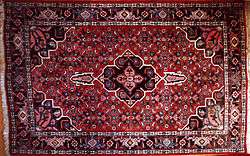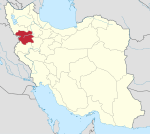Bijar (city)
| Bijar بيجار | |
|---|---|
| City | |
 A modern Bijar rug | |
 Bijar بيجار Location in Iran | |
| Coordinates: 35°52′22″N 47°36′10″E / 35.87278°N 47.60278°ECoordinates: 35°52′22″N 47°36′10″E / 35.87278°N 47.60278°E | |
| Country |
|
| Province | Kurdistan |
| County | Bijar |
| Bakhsh | Central |
| Population (2016 Census) | |
| • Total | 50,014 [1] |
Bījār (Persian: بیجار; Sorani Kurdish: بیجاڕ,[2] Kurdish: Bîcar) is a city and capital of Bijar County, Kurdistan Province, Iran. At the 2011 census, its population was 47,926, in 14,970 families.[3] Ethnically the population is predominantly Kurdish-speaking Shia Kurds.[4]
With an elevation of 1,940 metres, Bijar has been called the Roof of Iran.[5]
The term bijar could be a variation of bajar (i.e. city in Kurdish) and the complete name of the city Bijar-e Garrus (city of Garrus, the old name for the province). Among other suggested etymologies for bijar is bid-zar (land of willow tree), which is linguistically unlikely.
Bijar is known internationally for its elegant and ancient carpet and rug designs.
History
Historically, Bijar has been part of the Garrus administration unit. Before the creation of Zanjan province by the Pahlavi regime (after WWI), the wider region of Garrus covered Suhreward, the birthplace of Shahab al-Din Suhrewardi, the famous Persian philosopher of illumination.[6]
The city was mentioned in the 15th century as a village belonging to Shah Ismail, the first ruler of the Safavid dynasty; Bijar became a town during the 19th century. During World War I it was besieged and occupied by Russian, British, and Ottoman troops who, with the aid of the 1918 famine, halved the pre-war population of 20,000.[7]
Architecture
The historical fort of Qam Cheqay (45 km NE of Bijar) probably dates back to the Median era and is the oldest castle in the Kurdistan province. The castle had been used until the Sasanid era and it is an example of the ancient architecture of Kurdistan.
Another historical building, Emamzadeh Aqil, located in Hasan Abad (Yasukand) 45 km east of Bijar, is one of the remaining Seljuk buildings. This square building (6*6.5 m) with a collapsed dome houses Islamic religious texts written in Kufic script.
During the Mongol invasion of Iran in the 13th century, Genghis Khan (1162–1227) occupied Bijar and built Genghis Castle near the city.[5] It is now a ruin on the Bijar—Sanandaj road.[8]
Bijar's bazaar, with its unique design, is one of the attractions of the city. The roofed bazaar built in the Qajar era is much younger than the old Safavid-era bazaar of Sanandaj, the Kurdistan capital. The bazaar of Bijar consists of a main north–south roofed pathway, an eastern section (Timcheh-e Haj Shahbaz) and a western section (Timcheh-e Amir Toman).
Rugs

Bijar has enjoyed fame for its carpets since the Achaemenid era (550–330 BCE). Present day carpets and rugs have 100–200 Turkish knots per inch and are distinguished by their stiff and heavy wool foundation, created by "wet weaving" and beating the threads together with a special metal tool. Bijar carpets are famously stronger and longer-lasting than any others. They are made by Kurdish women in the villages around the town. The loom is set vertically against the side of the house. The designs have strong clear colours and have never been out of fashion with overseas buyers.[9] Nowadays dyes are high quality synthetics.
The motifs are mainly floral adaptations of classical Persian designs. Herati and boteh motifs are common, as are central medallions and sometimes representations of animals and willows. These are set against a dark background of blue, red or green. In relation to the size of the carpet, borders are small, with up to eight bands.[10]
Education
The Iranian Payame Noor University has opened a branch in Bijar-e Garrus and the Garrus Research Center is affiliated with the university.
Notable Bijaris
Prominent politicians and army officers in the Iranian army have come from Bijar. Amir Nezam Garrusi (1820–1900) was born in Bijar to a Kabudvand family.[11] As colonel of the Garrus Regiment, he took part in Muhammad Ali Shah's unsuccessful Herat Campaign. As a diplomat in Paris, he had dinners with Napoleon. He later acted as an Iranian diplomat to the Sublime Porte. General Garrusi joined in the 1880 suppression of the Kurdish uprising by the Sheikh Ubeydullah of Neri. He also played a part in the murder of Cewer Agha, the predecessor of Simko, the Kurdish leader.
The family of Rear Admiral Gholamali Bayandor (1898–1941) came from Bijar.
Among academic figures from Bijar is Dr Kamran Nejatollahi (1953–1978), a young civil engineering professor in the Polytechnic University of Tehran (now Amirkabir). He was killed during a peaceful sit-in at the university, presumably by Savak snipers. He is now regarded as an early martyr of the Islamic revolution and is buried among "political dissidents" in Behesht-e Zahra in Teheran.[12]
The poet Fazel-Khan Garrusi (1784–1843) was born into a Bijar family before moving to Teheran.[13]
Abdollah Ramezanzadeh, the spokesman of the former Khatami government, was born and raised in Bijar. He was the governor of Kurdistan Province 1997–2001, but has been in prison since the disputed 2009 presidential election.
Farhad Aslani (1966– ) the actor was born in Bijar.
Other prominent Bijaris include bodybuilding champion Baitollah Abbaspour (1979– ) and footballer Eshaq Sobhani (1984– ).[5]
Mr Shahriari, the prominent Iranian TV personality, comes from Bijar.
In June 2008, 21-year-old Hana Abdi, former student of Payame Noor University in Bijar and a member of the Azarmehr Organization of Women of Sanandaj, was sentenced to prison for five years but released after 15 months. The Iranian Revolutionary Court had charged her with "enmity against God" and "gathering and colluding to harm national security".[14]
References
- ↑ https://www.amar.org.ir/english
- ↑ Bijar (city) can be found at GEOnet Names Server, at this link, by opening the Advanced Search box, entering "-3056389" in the "Unique Feature Id" form, and clicking on "Search Database".
- ↑ "Census of the Islamic Republic of Iran, 1385 (2006)". Islamic Republic of Iran. Archived from the original (Excel) on 2011-11-11.
- ↑ World Factbook (Online ed.). Langley, Virginia: US Central Intelligence Agency. 2015. ISSN 1553-8133. Retrieved 9 October 2017.
- 1 2 3 "Bijar". Toiran. Retrieved 8 October 2017.
- ↑ Mulla Sadra's Transcendent Philosophy, p. 12, at Google Books
- ↑ "Bijar". Encyclopædia Iranica. Retrieved 8 October 2017.
- ↑ "Changiz Castle". Tell Me About Iran. Retrieved 8 October 2017.
- ↑ Thompson, Jon (1988). Oriental carpets from the tents, cottages, and workshops of Asia (1st American ed.). New York: Dutton. pp. 38–39, 116–119. ISBN 0525246975.
- ↑ Bamborough, Philip (1989). Antique oriental rugs and carpets. London: Spring. pp. 56–57. ISBN 0600566196.
- ↑ "Amir Nezam Garrusi". Encyclopæda Islamica. Retrieved 8 October 2017.
- ↑ "The martyrdom of Doctor Nejatollahi by the agents of Pahlavi Regime". Islamic Revolution Document Center. Retrieved 8 October 2017.
- ↑ "Fazel Khan Garrusi, Mohammad". Encyclopaedia Iranica. Retrieved 9 October 2017.
- ↑ "Kurdish women's rights activist released in Iran". Amnesty International. Retrieved 8 October 2017.
